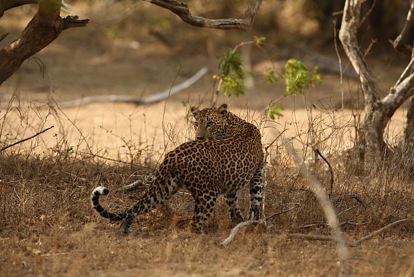Yala National Park in Sri Lanka (also known as Ruhunu National Park) is one of the best national parks in the world to see the leopard, a sub-species called Panthera pardus kotiya. It has one the highest densities of leopards in the whole world.
Yala’s rising popularity as a park to see the leopard has made it one of the top draws for tourists to Sri Lanka and a must-visit destination on anyone interested in nature tourism / photography in Sri Lanka..
This was my third visit to the Park after going there for a week each in July 2004 and July 2005 – in between those two visits, nature had wreaked havoc in Sri Lanka through the mighty waves of the tsunami killing 30,000 people on the beautiful tear-drop shaped island. Yala had borne the brunt of the tsunami’s fury, which completely destroyed the hotel in which I had stayed in in July 2004 and killed half of its staff along with many tourists who were out on their morning game-drives. But eye-witness accounts seem to suggest that the animals had escaped to higher ground before the tsunami hit.
This time round I was supposed to spend 4 days in Yala, one day in Udwalawe and two days in Kithurgala (predominantly to see the Oriental Dwarf Kingfisher) – after the first three days in Yala I decided to stay all 7 days in Yala. My main focus of this visit was to photograph leopards, eagles (predominantly the Grey-headed Fish Eagle, the Changeable Hawk-Eagle and the White-bellied Sea-Eagle) and kingfishers (the Pied Kingfisher was top on my list) –the trip proved to be a bonanza from the birding as well as the photography perspective. I have listed some of the more memorable morning/evening drives below – one can either spend the whole day – from sunrise to sunset – inside the park or exit as the sun gets up in the sky (around 10 am) and then re-enter at around 230 pm. I normally do the latter as anyway mid- day is a time of rest for most animals too.
Day 1 –28 July – A preliminary taste of the abundance of mammals and birds of Yala
Day 1 began at 5:30 a.m. with a visit to the nearby Tissamaharama wetlands – the naturalist-guide with me said that it was a good place to see and photograph eagles and kingfishers. The Tissa wetlands are predominantly paddy fields bordering a road, with rustic houses (that belong to the paddy farmers) dotting the road at regular intervals. The morning was fantastic not only from a birding perspective but also yielded good shots of a Purple Heron bathed in glorious morning light and of a Changeable Hawk-Eagle eating a lizard (the latter taken after using shrubs and trees as cover and walking with a tripod and a heavy 600 mm lens through almost ankle-deep mud to reach a vantage point which was eye-level with the eagle). We also saw a large number of bats hanging upside down from trees – but a backdrop against a brightly lit sky made them difficult to photograph.
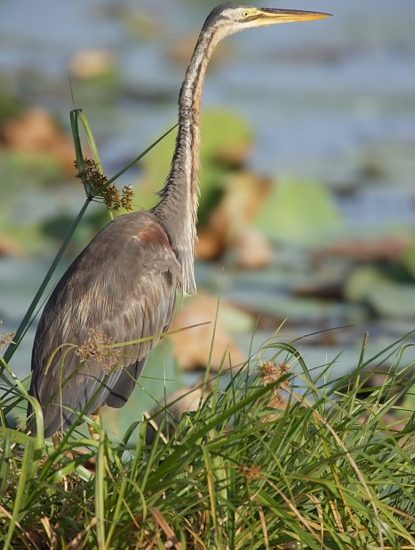
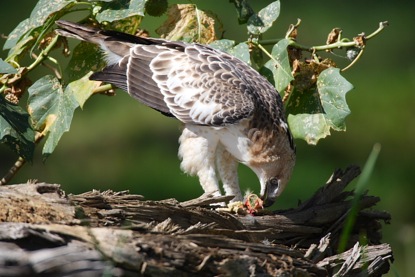
From Day 1 evening, we started to go into the main Yala National Park Block 1, which is the area open to tourists. The habitat comprises dry lowland with shrubs and trees punctuated with numerous brackish lagoons and waterholes – ideal spots to see a leopard in late afternoon or sunbathing crocodiles. Crocodiles, spotted deer, wild buffalos, grey herons, Asian openbills and other birds were quite common.
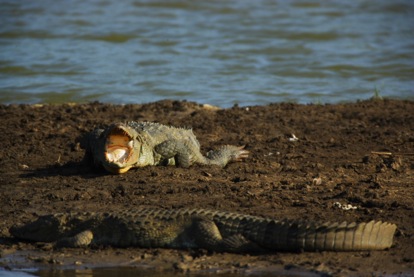
Day 2 – 29 July – Abundant wildlife sightings but none of the Big Three
Day 2 morning provided opportunities to photograph spotted deer (chital) at a waterhole and a Common Blue Kingfisher at reasonably close range. Wildlife sightings continued to be abundant but Yala’s ‘Big Three’ i.e. the leopard, the elephant and the sloth bear continued to elude us.
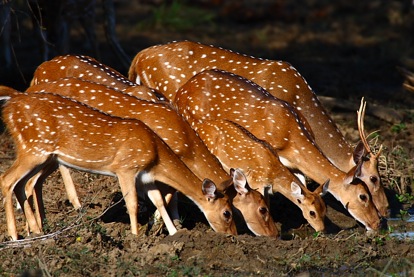
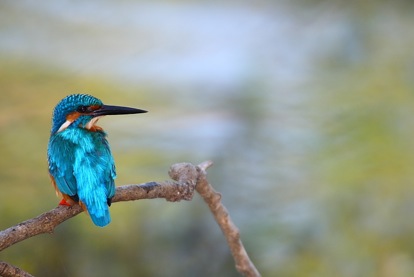
Day 2’s evening highlight was my first close range sighting of a grey headed fish eagle (though very late in the evening in failing light) which swooped into the water, picked up a large fish and then started to eat perched on a tree reasonably close to us.
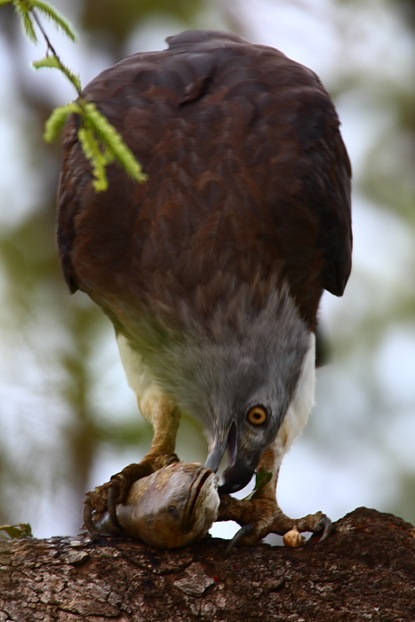
Day 3 – 30 July 2007 – The Eagle encounters continue
Day 3 (30 July 2007) was again very good in terms of sightings and we again saw a Changeable Hawk Eagle (this time a fully grown one – note the darker colours from the earlier one) killing a lizard and eating it. We spent over 30 minutes reasonably close to the eagle after carefully approaching it in our Land Rover. The vehicle presumably acts as a hide – if one had stepped out of the vehicle, the eagle would have flown away – biped humans scare wild animals and birds alike.
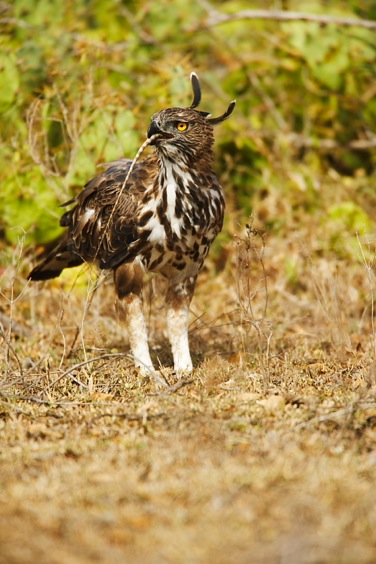
At the end of Day 3 (30th July) – which was our second-last scheduled day in Yala, we still had not seen any of the Big Three. Hetti was understandably disappointed at what he said was his worst run of luck – we then decided to spend the whole of the next day from 5:30 a.m. to 6:30 p.m. inside the park. Most tourists see a leopard in Yala on their second or third game drive itself and here I was – 6 game drives & no leopard. Anyway, I had already decided to extend my stay in Yala irrespective of what we saw on 31st July as the weather was good and I was having a good run of luck with the eagles at least – I did not mention this to Hetti yet.
Day 4 – 31st July – of leopards and a charging tusker
The day started with us seeing a dead sambar near a waterhole at around 7am and spotted deer alarm calls nearby – an apparent kill by a leopard – we decided to wait near the waterhole confident that the leopard would return. Soon other jeeps joined us – everyone used to wait for around 20 min and then leave. We waited for over 3 hours at the same spot for the leopard to appear – then a jungle crow descended on the carcass and started to peck at it. We had not seen a single injury on the sambar’s neck or on its body. Normally a leopard would not tolerate a crow on its kill. So we began to suspect that maybe it was not a leopard kill and that the deer could have died of snake-bite or some other cause. Just then, a passing tourist jeep informed us of a leopard at another spot – news of a sighting in Yala travels fast through word of mouth. By the time we reached the spot, there was no sign of the leopard but there was a half eaten large male spotted deer kill lying far away under the tree. Just then another jeep came to the spot and we were informed – much to our chagrin – that a leopard had been seen at the spot where we were originally waiting. He had come, drunk water at the waterhole and without touching the kill had melted into the jungle. Two jeeps had seen him. We could not believe our bad luck – we had spent three uncomfortable hours at the same spot and the leopard had to emerge just when we left for the other leopard – it was not that the leopard had not emerged because we were waiting there, it was just our bad luck continuing. We then decided to wait at the same spot where we were.
A little after 12 noon – after two hours in the scorching sun – our fortunes changed and finally our patience was rewarded. We were the only jeep patient enough to wait, knowing that the leopard would come back to continue eating his half-eaten kill. We saw the leopard emerge through the undergrowth and start eating the male deer. The leopard was around 125 m away behind a lot of foliage – so photographic opportunity was at best limited. Then we saw a huge wild boar creep up behind the leopard. When the leopard sensed it, he turned around and in one big leap, climbed up the tree. Leopards in Yala are scared of wild boar because of their twin tusks or “tushes” which can prove fatal in a fight. Then the wild boar started eating the leopard’s kill while the leopard watched from a high branch in the tree. We waited for an hour more hoping the wild boar would go away. When he refused to oblige, we decided to drive around and come back later.
By the time we returned at around 3 pm, the wild boar was gone and the leopard had dragged the kill much closer to the road and therefore in a much better spot to see. We saw her eat a part of the deer and then all of a sudden she stood up all alert and left the kill but not before she gave us one glance as if to say – “I will be back”.
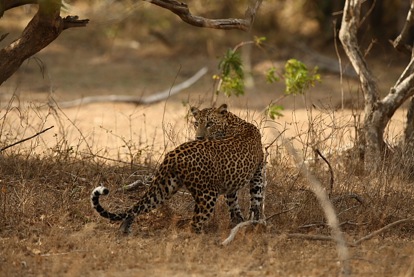
Soon we realized why she left, as we saw the male wild boar come back to eat the kill. We then left from there knowing that she was not coming back till the boar was gone.
At 4:15 pm, we had one more stroke of luck – we saw our second leopard for the day! This one was a male perched high on a tree across a large pond. We saw him descend the tree, walk towards another tree, climb and descend it immediately, drink water at the pond and then disappear into the jungle. There were at least 15 jeeps who saw the whole show which went on for over 45 minutes.
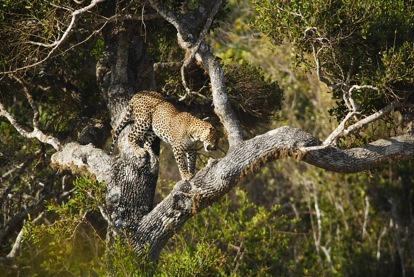
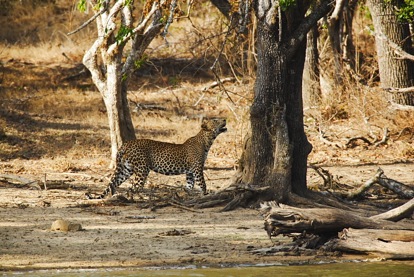
The charging tusker….
Soon after we left the leopard, we chanced upon a tusker who was evidently in a state of “musth”*.
In any case, we cautiously followed this tusker along the road waiting for a chance to pass him so that I could get a frontal shot of the elephant. After about 5 minutes of being behind the elephant, all of a sudden the tusker paused at a crossroad inside the jungle as if undecided which way to go. We were around 5 meters behind him with another jeep behind us. Then all of a sudden, there was pure chaos.
With a huge trumpeting noise, the tusker turned around and with its trunk swaying wildly charged our jeep – in those seconds of terror, I was screaming “Go!Go!” to the driver who I guess was paralysed with fear – Manat was screaming too and I vaguely remember other screams – presumably from the people in the jeep behind us (I still don’t understand why, as it was highly unlikely that the tusker after overturning and trampling us was going to feel the need to keep going – but guess rational thoughts at moments like those are impossible.) The only person who kept his cool was the jungle tracker who was accompanying us and was sitting next to the driver – he pounded loudly on the jeep side with his hand while yelling back at the charging and trumpeting elephant – the tusker stopped charging literally two feet away from the jeep and then took a few steps back too. I remember my screaming stopping. I remember feeling unbridled admiration for the brave tracker who had surely saved us from grievous injury, if not death (like punishment meted to criminals in the days of yore) at the foot of an elephant -and I remember looking at Hetti who to his credit had not screamed, but whose face betrayed sheer terror. A good few seconds elapsed before our hearts which had stopped beating altogether resumed their normal functioning though with a palpitating irregularity and I remembered that I was holding a camera. I managed four photographs of the tusker before he turned around again and proceeded. I had half a mind to keep on following him – I guess I was not thinking rationally so soon after a terrifying experience – assuming that the next time he charged, I would not panic and I would actually get a few photographs of a charging elephant like the ones I have of a charging rhino at Kaziranga in Assam, but luckily the elephant disappeared into the thickets. Anyway I don’t think anyone else including the tusker would have been too sold on the idea of us following him again.
The photograph below is a few seconds after the tusker retreated a few steps after charging us – one can clearly see the liquid running down the side of his head and his trunk still swaying (perhaps if we had moved the jeep towards him even a little more, he would have sent the antique Land Rover straight into a scrapyard).
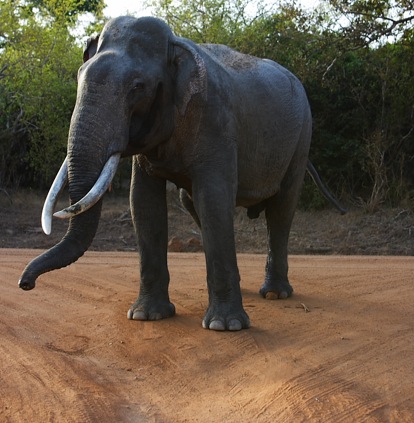
Third leopard of the day
Soon after we left the tusker, we decided to head back to the hotel as it was already 515 pm and we had been out the whole day – we were dusty, tired , hungry and not to mention still a bit shaken up.
On the way back, right next to the main arterial road of the park, we saw another leopard drinking water in what is perhaps the best light for photographing animals with reflective yellow / orange skin coats like leopards, tigers, spotted deer, etc. I quickly mounted my monster lens on the tripod and fired away over 40 shots of the leopard as it drank water, got up and walked away into the forest.
I told Hetti that since our luck had changed for the better, we must stay back in Yala and continue to ride our wave of luck.
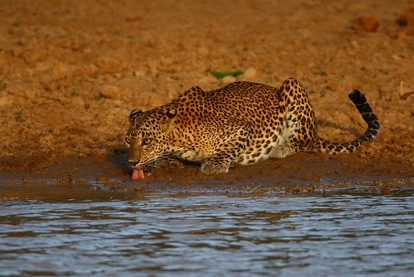
Day 5 – 1st August – Back to the leopard
In the morning after driving around for some time, we headed back to the place where we had seen the female leopard the previous day. We were the third jeep to arrive there – she was there again below the tree with the kill. Soon we were joined by 5 other vehicles with tourists. After around 30 minutes of hushed silence punctuated by the sounds of cracking bones, suddenly once again from the undergrowth a huge herd of wild boar emerged – this time it was not just one alpha male, there were other males, females and even small baby boar – at least 20 of them. On seeing them, she immediately ran away into the dense foliage – the last that we saw of her.
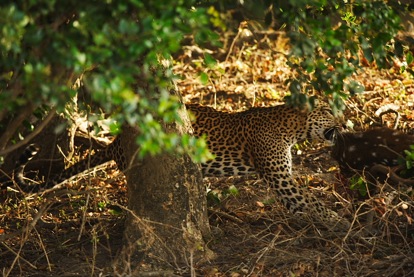
On the way from the park to the hotel, we saw a Grey-headed Fish-Eagle again perched on the edge of a pond. As if on cue, it swooped down picked up a green frog and started eating it on a mound across the pond.
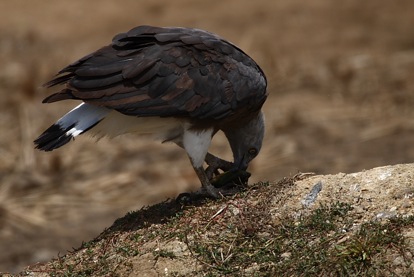
White-bellied Sea-Eagles
In the afternoon on August 1 we decided to go to a spot where we had seen white bellied sea eagles hovering nearly everyday. Lady luck continued to be with us as we saw a pair perched on a dead V-shaped tree near the water. As I was clicking their photographs, one of them decided to fly off – I shot off 6 frames in rapid succession within the space of 1 second resulting in the two shots below.
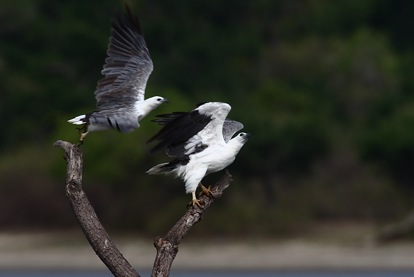
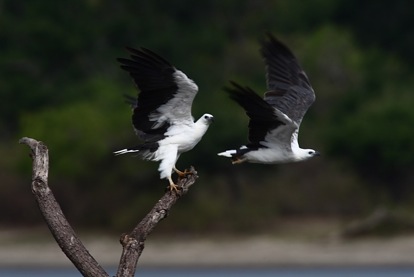
We saw another tusker in the evening on 1st August drinking water in a pond for what seemed to be a really long time – but guess it had to fill an elephantine tummy. We also saw a pair of woolly necked storks – one of them standing steady while I clicked a few portraits and a grey headed fish eagle again at very close quarters (pictures on the following pages).
Day 6 – 2nd August – Bad Weather torments
After 5 days of bright and sunny weather, 2nd August saw heavily overcast skies with intermittent showers. This translated into poor low light conditions for photography but bird sightings continued to be good with sightings of uncommon birds which included a blue- faced malkoha, a sirkeer malkoha, a white-rumped shama and an emerald dove.
Day 7 – 3rd August – we leave the park with a heavy heart as we see another leopard at a kill
The last game drive into the park on the morning on 3rd August capped what was one of the most rewarding safaris for a long time. On 2nd August in the evening, we had heard continued alarm calls of spotted deer – we had waited to see if we could see a lurking leopard but there was no sign of one and the alarm calls had stopped after some time. On the 3rd August morning, we heard that a leopard was there at the same spot with a large kill. We rushed to the spot and were the 10th jeep to the spot. The leopard was behind a tree with his kill lying nearby. We waited for almost 2 hours to see if the leopard would come into a more open spot but the leopard rolled over and lay down – obviously very well fed. I had to get back to Colombo which was a good 6 hours drive away to board a flight which would transport me back to daily normal life in Hong Kong… so I left the leopard and drove away, already eager to return again next year.
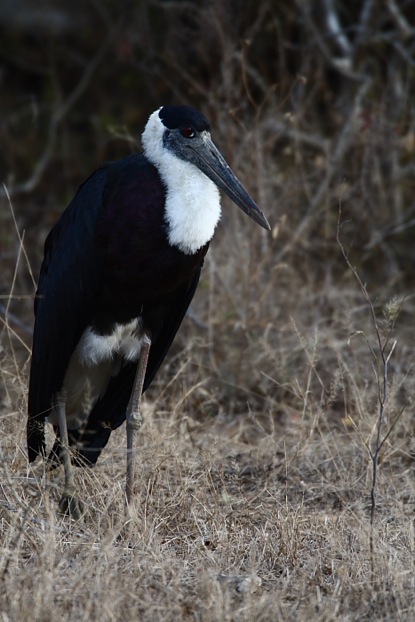
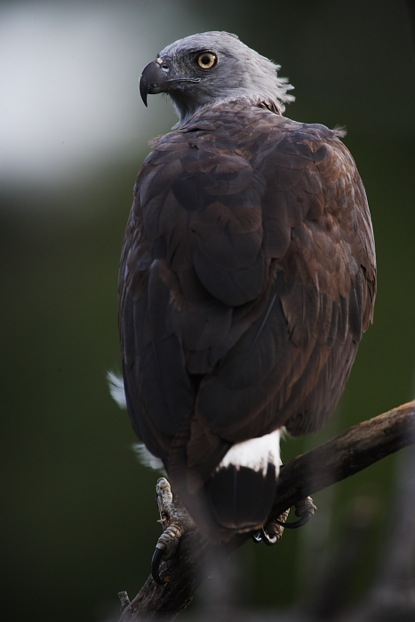
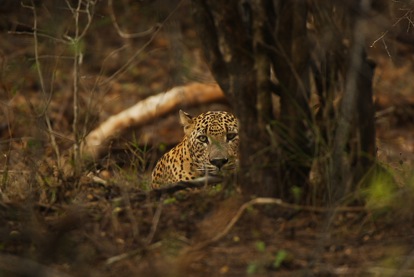
*State of musth – in this period elephants begin to secrete a thick fluid through the temporal ducts from the temporal glands on the side of their head – elephants are known to be most aggressive during this period which is accompanied by a rise in their reproductive hormones and any musth elephant is extremely dangerous to humans. In zoos, musth is often the cause of fatal accidents to elephant keepers. Kanha National Park’s most magnificent domesticated elephant – Shivaji – had gone on a rampage during his state of musth running amok amongst nearby villages and chasing and goring a forest guard to a tree.
One of the touted explanations for the aggression during musth is that the swelling of the temporal glands during this period presses against the elephants eyes and causes the elephant severe pain. But the sheer aggression of elephants during this period has meant that there is no consensus on either the cause of this “state of musth” or on the reasons why this state translates into increased aggression.
